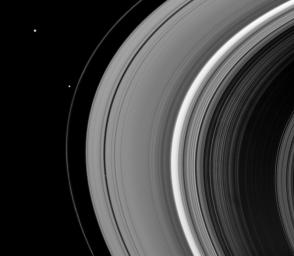
|
Moons in a Row
- Click the image above for a larger view
- Full-Res JPEG (799 x 696) (43.6 kB)
- Full-Res TIFF (799 x 696) (556.9 kB)
Caption:
Three of Saturn's satellites are visible in this snapshot from the Cassini spacecraft.
Janus (179 kilometers, or 111 miles across) is in the top left of the image. Pandora (81 kilometers, or 50 miles across) is just outside the F ring.And, Pan (28 kilometers, or 17 miles across) is the small moon that has cut a path inside the rings below the center of the image.
This view looks toward the unilluminated side of the rings from about 27 degrees above the ringplane. The image was taken in visible light with the Cassini spacecraft wide-angle camera on Dec. 7, 2008 using clear filters: CL1 (635 nm) and CL2 (635 nm). The view was obtained at a distance of approximately 1.031 million kilometers (641,000 miles) from Pan and at a Sun-Pan-spacecraft, or phase, angle of 33 degrees. Image scale is 62 kilometers (38 miles) per pixel.
Background Info:
The Cassini-Huygens mission is a cooperative project of NASA, the European Space Agency and the Italian Space Agency. The Jet Propulsion Laboratory, a division of the California Institute of Technology in Pasadena, manages the mission for NASA's Science Mission Directorate, Washington, D.C. The Cassini orbiter and its two onboard cameras were designed, developed and assembled at JPL. The imaging operations center is based at the Space Science Institute in Boulder, Colo.
For more information about the Cassini-Huygens mission visit http://saturn.jpl.nasa.gov/ . The Cassini imaging team homepage is at http://ciclops.org .
Cataloging Keywords:
| Name | Value | Additional Values |
|---|---|---|
| Target | Saturn Rings | F Ring, Janus, Pan, Pandora |
| System | Saturn | |
| Target Type | Ring | Satellite |
| Mission | Cassini-Huygens | |
| Instrument Host | Cassini Orbiter | |
| Host Type | Orbiter | |
| Instrument | Imaging Science Subsystem (ISS) | |
| Detector | Wide Angle Camera | |
| Extra Keywords | Grayscale, Visual | |
| Acquisition Date | ||
| Release Date | 2009-01-14 | |
| Date in Caption | 2008-12-07 | |
| Image Credit | NASA/JPL/Space Science Institute | |
| Source | photojournal.jpl.nasa.gov/catalog/PIA10556 | |
| Identifier | PIA10556 | |
